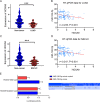MiR-182-5p and its target HOXA9 in non-small cell lung cancer: a clinical and in-silico exploration with the combination of RT-qPCR, miRNA-seq and miRNA-chip
- PMID: 31906958
- PMCID: PMC6945423
- DOI: 10.1186/s12920-019-0648-7
MiR-182-5p and its target HOXA9 in non-small cell lung cancer: a clinical and in-silico exploration with the combination of RT-qPCR, miRNA-seq and miRNA-chip
Abstract
Background: MiR-182-5p, a cancer-related microRNA (miRNA), modulates tumorigenesis and patient outcomes in various human malignances. This study interroted the clinicopathological significance and molecular mechanisms of miR-182-5p in non-small cell lung cancer (NSCLC).
Methods: The clinical significance of miR-182-5p in NSCLC subtypes was determined based on an analysis of 124 samples (lung adenocarcinomas [LUADs], n = 101; lung squamous cell carcinomas [LUSCs], n = 23) obtained from NSCLC patients and paired noncancer tissues and an analysis of data obtained from public miRNA-seq database, miRNA-chip database, and the scientific literature. The NSCLC samples (n = 124) were analyzed using the real-time quantitative polymerase chain reaction (RT-qPCR). Potential targets of miR-182-5p were identified using lists generated by miRWalk v.2.0, a comprehensive atlas of predicted and validated targets of miRNA-target interactions. Molecular events of miR-182-5p in NSCLC were unveiled based on a functional analysis of candidate targets. The association of miR-182-5p with one of the candidate target genes, homeobox A9 (HOXA9), was validated using in-house RT-qPCR and dual-luciferase reporter assays.
Results: The results of the in-house RT-qPCR assays analysis of data obtained from public miRNA-seq databases, miRNA-chip databases, and the scientific literature all supported upregulation of the expression level of miR-182-5p level in NSCLC. Moreover, the in-house RT-qPCR data supported the influence of upregulated miR-182-5p on malignant progression of NSCLC. In total, 774 prospective targets of miR-182-5p were identified. These targets were mainly clustered in pathways associated with biological processes, such as axonogenesis, axonal development, and Ras protein signal transduction, as well as pathways involved in axonal guidance, melanogenesis, and longevity regulation, in multiple species. Correlation analysis of the in-house RT-qPCR data and dual-luciferase reporter assays confirmed that HOXA9 was a direct target of miR-182-5p in NSCLC.
Conclusions: The miR-182-5p expression level was upregulated in NSCLC tissues. MiR-182-5p may exert oncogenic influence on NSCLC through regulating target genes such as HOXA9.
Keywords: HOXA9; Non-small cell lung cancer; RT-qPCR; miR-182-5p; miRNA-chips; miRNA-seq.
Conflict of interest statement
The authors declare that they have no competing interests.
Figures










References
-
- Pang L, Han S, Jiao Y, Jiang S, He X, Li P. Bu Fei decoction attenuates the tumor associated macrophage stimulated proliferation, migration, invasion and immunosuppression of non-small cell lung cancer, partially via IL-10 and PD-L1 regulation. Int J Oncol. 2017;51(1):25–38. doi: 10.3892/ijo.2017.4014. - DOI - PMC - PubMed
Publication types
MeSH terms
Substances
LinkOut - more resources
Full Text Sources
Medical
Research Materials

